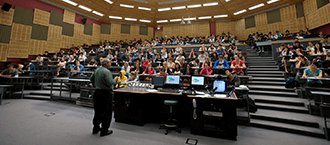- Academic Technology
Asynchronous Learning and the Future of the Higher Ed Classroom

We recently put together some research on what the post-pandemic higher ed classroom will look like. It’s fascinating to see how asynchronous learning is becoming increasingly essential to the educational experiences of today and beyond.
Prior to the pandemic, only about a third of all US college students had taken an online course. Throughout the pandemic, research showed that students and faculty each had more positive attitudes toward online and hybrid courses during the fall 2020 and spring 2021 semesters than they did prior to pandemic.
In a post-pandemic survey of 1,500 US college students, 70% said they would be likely to take another online course in the future. Both students and faculty indicated that they want more options and flexibility, and that online learning is an essential part of the new normal. 46% of students indicated that they would like to take some of their courses in a fully online format, and 33% want to take some courses as a combination of in-person and online formats. Faculty preferences were similar: 32% of faculty indicated that they would like to teach some of their courses in a fully online format, and 30% wanted to teach some courses as a combination of in-person and online formats.
Brandon Busteed of Forbes sums it up well when he says, “It will become a norm that all lectures are video recorded for student review later. When asked what they’d like to see continue after the pandemic, the top preference among college students (desired by 79% of them) is to keep lectures available online.”
We’ve assembled the full data, including sources, in a compelling free infographic that you can download here. Read it to understand the big shift that is happening now with how colleges and universities use video.




